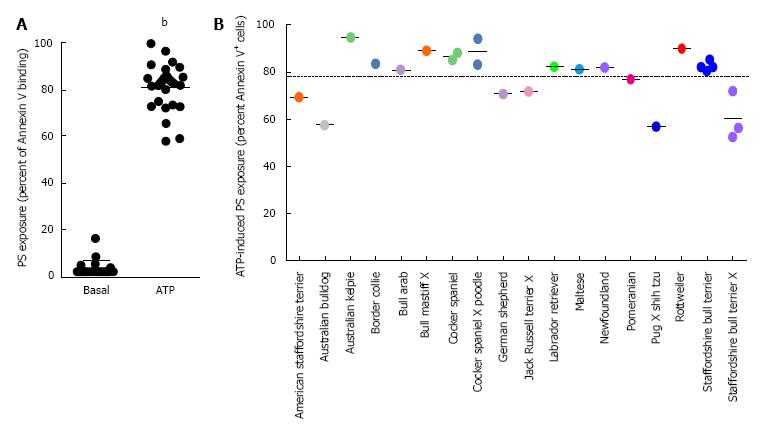Copyright
©The Author(s) 2016.
Figure 1 ATP induces phosphatidylserine exposure in erythrocytes from multiple dog breeds.
Erythrocytes, from 17 pedigree and eight crossbreed (X) dogs, in NaCl medium were incubated for 24 h at 37 °C in the absence or presence of 1 mmol/L ATP. Cells were labeled with FITC-conjugated Annexin V and analyzed by flow cytometry. The bars represent group means (A and B). A: The symbols represent the percentage of Annexin V+ erythrocytes, from each dog, following incubation in the absence (basal) or presence of ATP; bP < 0.0001 ATP vs basal; B: The symbols represent the percentage of ATP-induced PS exposure in erythrocytes, from each dog, determined as the difference in the percentage of Annexin V+ erythrocytes following incubation in the presence and absence of ATP. The broken line represents the mean ATP-induced PS exposure from all dogs. The symbols for Staffordshire bull terrier X represent a Staffordshire bull terrier and Australian kelpie cross, Staffordshire bull terrier and bull terrier cross, or a Staffordshire bull terrier cross. PS: Phosphatidylserine.
- Citation: Faulks M, Kuit TA, Sophocleous RA, Curtis BL, Curtis SJ, Jurak LM, Sluyter R. P2X7 receptor activation causes phosphatidylserine exposure in canine erythrocytes. World J Hematol 2016; 5(4): 88-93
- URL: https://www.wjgnet.com/2218-6204/full/v5/i4/88.htm
- DOI: https://dx.doi.org/10.5315/wjh.v5.i4.88









